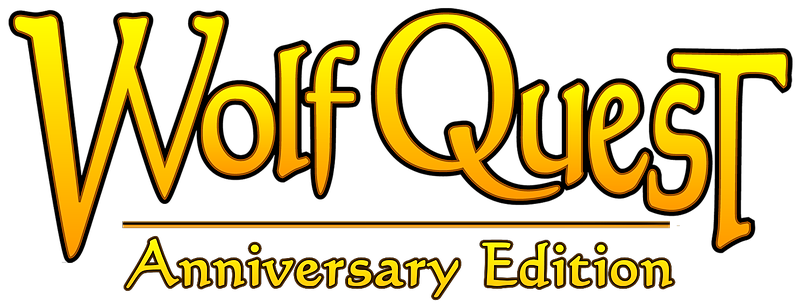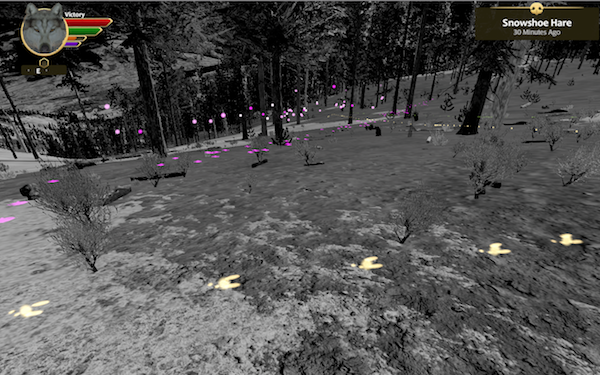WOLF CUSTOMIZATION
Create and customize your wolf from My Wolves button in the main menu. Choose your wolf's name, gender, coat, eye color, howls, ears, other body options, attributes. You can also write a short bio and assign personality traits that will pass down to your pups.
See the article Wolf Customization for lots more information.
WOLF CONTROLS
MOVING
TROT: Press W or Up Arrow. Tap/double tap W key to walk/auto-walk.
TROT/GALLOP: Tap SHIFT to toggle between gaits
SPRINT: Press-hold SHIFT (Hint: sprinting depletes your stamina at a faster rate.)
STEER: Move mouse left or right.
Note: The ARROW keys do the same as WASD. WolfQuest: Anniversary Edition has a new control scheme based on popular RPG games. It is different than WolfQuest 2.7 (so it might take some practice).
JUMP: Press X
STALK: Press-hold Ctrl and W at the same time
CAMERA
RIGHT-CLICK to swing the camera around your wolf, to look in other directions.
Use mouse scroll-wheel or trackpad to zoom in and out.
PupCam
Enjoy getting a closer look at what each pup is doing with PupCam. Tap Shift-F to switch to PupCam, where you can follow each pup around. Tap Shift-F again to jump to the next pup, and so on, and finally back to your wolf Or press spacebar to jump back to your wolf anytime.
PHOTO MODE
Press SHIFT-P to freeze time and SPACEBAR to take a photo. Press SHIFT-P again to exit Photo Mode.
Use camera controls to move around the scene.
Photos are saved here:
- Windows: Documents/My Games/Wolf Quest Anniversary/User Files/Screenshots/
- Mac: [YourUserDirectory/WolfQuest Anniversary/User Files/Screenshots
SLEEPING and RESTING
Sleeping restores your health (resting does too, but at a slower rate). You must sleep about 16 hours a day to maintain energy (just like a real wolf).
Be careful about where you sleep as you may be vulnerable to disturbance while snoozing. It is risky to sleep in stranger pack territories.
Time accelerates when you sleep.
SLEEP: Press Z
WAKE UP: Press SPACEBAR
REST: Press R (cycle through sitting and four laying positions)
COMMUNICATING
HOWLING
HOWL: Tap H for Howl 1 and double-tap for Howl 2.
Howling can build pack affinity and mark territory.
Howling in stranger pack territory is dangerous and will attract rival wolves, so be ready. Rival wolves may howl back.
When you are looking for a mate, howl and nearby dispersal wolves will howl back, with a white icon marking their location on the compass.
Your Secondary Howl calls your mate to you, wherever you or they are.
When at a carcass, howl to mark its location on the compass and World Map until it has been consumed. (In multiplayer, this will also share the carcass's location with all current members of your pack.)
EMOTES
Use emotes to interact with other wolves and build or discourage interest, or strengthen pack affinity.
Choose emotes for ears, voice, body, and tail. Add your most used emotes to favorites.
EMOTES: Press-hold E and select emotes with mouse/cursor.
To add/remove from favorites: click-hold on the desired emote and after a moment, the add/remove button will appear.
Command Emotes:
Many emotes can be used to give different commands to your mate and/or your pups. Here is a list of emotes that have command effects:
- Woof: Woofing tells pups and packmate to go home or go to safety, depending on the context:
- At your homesite or when moving to a new den or rendezvous site:
- Woofing will tell your pups to go into the den or patch of tall grass nearby.
- At the den, woofing at your mate or packmates tells them to stay home with the pups.
- If you are away from the homesite with your mate or packmates, woofing will send them home. Target the wolf you want to command before woofing.
- When there is no homesite, woofing at a packmate tells them to back off from danger (useful in a hunt or fight). Choose who to give this command to by:
• Targeting a wolf, or
• Coming within four meters before woofing.
- At your homesite or when moving to a new den or rendezvous site:
- Squeak: Calls your pups out of the den or out of nearby tall grass.
- Whine: Calls for your mate to come on a hunting trip with you.
- Secondary Howl: Calls your mate to you, wherever you or they are.
BITING (attacking)
The red BITE icon (jaws) appears when you are close enough to attack an animal.
Press-hold SPACEBAR to attack and bite it, holding on until you release.
HINT: To break free from another animal's bite: tap left/right movement keys (A/D on keyboard, left stick on controller) rapidly to break free.
Animals have more than one bite target (red dots, when targeted). Different bite locations do different amounts of damage and have different levels of risk to you. See Main Quest: Learn to Hunt for prey biting strategies and hints.
EATING and CARRYING FOOD and DRINKING
EAT: Tap the SPACEBAR when you see the green BITE icon (jaws) that appears when you can eat a carcass.
PICK UP MEAT: Tap and hold SPACEBAR when green BITE icon (jaws) appears to pick up a chunk of meat or small prey, which you can then carry elsewhere. Tap SPACEBAR again to put it down.
After a large meal, your energy drops as you digest. That is a good time to sleep and restore health.
Note: Eating no longer restores your health as in WQ 2.7. Health restores automatically and faster when you rest or sleep.
MARK CARCASS LOCATION: Carcasses often provide more food than you can eat in one sitting. When at a carcass, howl to mark its location on the compass and World Map until it has been consumed. (In multiplayer, this will also share the carcass's location with all current members of your pack.)
DRINK WATER: Tap the SPACEBAR when you are over water. You may get a small health boost.
SCENT VIEW
Tap V to switch Scent View on or off. Look for scents floating in the air or on the ground.
Airborne scents float with the wind so track them upwind (so they float towards you) to find prey animals or dangerous competitors.
Watch the scent meter in the upper right for information about the animal(s) and when the animal passed that way.
Different animals have different colored scents. Male scents might be darker in color than females and young.
Ground scents appear when you get close to other animals. Look for scented footprints that you can follow to their owner.
HINT: Competitor species may pose a threat to you, but following their scent trails can also lead you to a carcass -- if you are willing to fight them for it.
CONTROLLER SUPPORT
You can play using your Xbox or PS4 controller. Remapping options are in Game Settings: Controls panel.
REMAPPING CONTROLS
You can change many of the controls in the game through the Game Settings: Controls: Remap Controls screen.
Click on the control (the yellow button) you wish to change. It will change from the current keybind to "Listening".
Press the key or mouse button you would like to change that control to.
Press the Confirm button in the lower right to save your changes. That key or mouse button will now be associated with that action in the game.
METERS & INTERFACE
Wolf Badge
The wolf badge in the top left of the game screen provides key information about your wolf and pack.
Health: The red bar. Lose health during attacks,when biting and fighting other animals, and falling.
Energy: The green bar. Expend energy with action. You will have less energy when digesting a big meal.
Hunger: The orange bar. Wolves can go days without eating, but eventually you must find food.
Health and Energy recharge automatically, and faster when resting and sleeping.
Sleep: The purple bar. Wolves sleep for much of the day, so when this meter is empty, it is time for a nap!
Compass: Shows cardinal directions, as well as custom map markers and sometimes the destination for your current mission.
Territory: The hexagon above the compass shows whose territory you are in. Black (empty) means nobody has claimed this spot (safer for you to be out of rival pack territory). Other colors are keyed to pack territories shown on the World Map.
Mate health: Once you have a mate, the heart on your wolf badge indicates their health level. Mates will usually take care of themselves but they will also sleep when you sleep so you can help them restore. You can also mate health in Pack Stats.
Mate/pack affinity: The blue bar on the left side of your wolf badge indicates affinity.
- When you have a (prospective) mate and no pups this shows affinity between you and your (prospective) mate.
- When you have pups, this shows affinity among all of you in your family pack.
- When you have pups, there also will be a blue arrowhead on the blue affinity bar that indicates when pups might start leaving the den/grass. See: QUEST: Raise Pups
Affinity decreases over time and can be restored through social interactions. But your mate won't leave you. Learn more about pack affinity when you have pups in QUEST: Raise Pups.
You can also view pack affinity in Pack Stats.
World Map
Tap the M key or TAB to open the World Map. Tap again to close it
Use the map to locate yourself in the game world, see the territories of stranger wolf packs, and place markers which will appear on your compass in the game.
Territory: The territory overlay shows the rival packs and how strong their claim is: the darker the color, the stronger the claim (and the more dangerous it is for you to enter). Watch out for rival wolves patrolling!
You can mark territory (Press P) to reduce the strength of rival pack territory but, as a lone wolf or pair, you can't claim territory of your own in Amethyst Mountain – it is just too crowded. (This is why you will later move to Slough Creek to establish your own territory to raise pups).
Markers: Place up to six custom markers on the map. These will show up on your compass and help you navigate.
Quests
Use the map (Press M or TAB) to see the Quests information. This will indicate what you are supposed to be doing to complete a quest.
See these articles for Main Quests gameplay tips:
- Quest: Find a Mate
- Quest: Learn to Hunt
- Quest: Establish Territory
- Quest: Find a Den
- Quest: Raise Pups
- Quest: Journey to Summer Home
- Quest: Loaf at Rendezvous Site
Competitor Fight or Flight Meter
The V-shaped Fight or Flight meter over a competitor's head reveals their mood. The Fight bar is on the left (orange-red) and the Flight bar is on the right (yellow).
Confrontation Tip
Try harassing competitors (growling, snarling, biting) and watch their Flight or Flight meter to see how they respond to your actions. Growling and snarling increase Flight permanently but also gives Fight a temporary boost. So a good strategy is to growl frequently, but not too frequently (you'll want the Fight meter to come back down before you growl again). Fight also slowly increases over time, so waiting too long is not a good idea. Running away reduces Flight - so stand your ground if you want to make good progress. Hold off on attacking if you don't want to take damage - you may be able to chase them away without any violence.
More HUNTING and FIGHTING Tips
Watch these videos:











